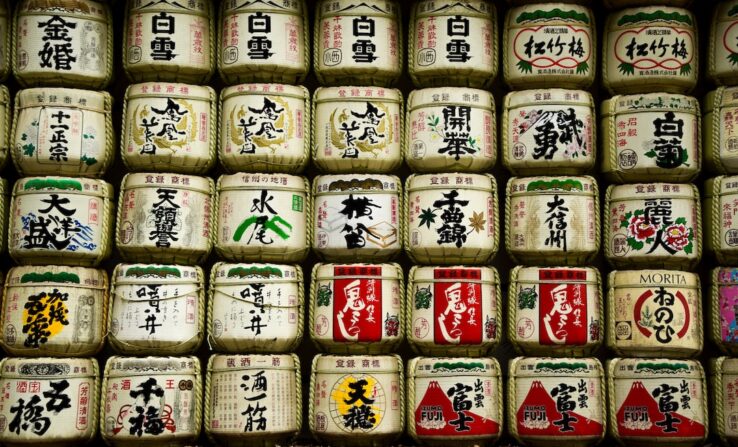Sake Education: Deepening Your Understanding of Japan’s Traditional Elixir
Everyone knows sake: it’s Japan’s ceremonial wine. What many may not realize, though, is that sake is not made with fermentation like traditional wine. The Japanese brew it like beer, leading to the phrase: you brew sake like beer, but drink it like wine.
Sake has a rich, symbolic history in Japan, as any sake specialist will tell you. A truly dedicated student could devote a lifetime to their sake education, as there is so much to learn. For now, though, a quick crash course will have to suffice in place of sake school–and if you have more time, take a look at our sake textbook.
In this guide, we’ll walk you through the history and tradition of sake, its importance in Japanese culture, and the many types of sake that you can try.
Questions for a Sake Specialist: What Is Sake?
Sake, or “nihonshu” is a form of Japanese rice wine. It uses a brewing process rather than fermentation vats common to viticulture. The alcohol content for average sake varies, but you can expect to have between 15 and 20% of ABV, or alcohol by volume.
Sake has a mostly clear, light color, not unlike Korean soju–a rice-based, distilled liquor similar to sake. Japan considers sake its national beverage. They reserve it for special occasions, particularly ceremonies and religious rituals.
Unlike tequila, though, Japan does not restrict the production of foreign sake. Breweries have been popping up across the West, producing high-quality sake that, in some cases, rivals that of the motherland.
Sake Taste
When you try sake at our sake school, you will find it has a sweet flavor. A sake specialist would tell you that it contains a subtle earthiness and a sort of umami sensation. Some describe it as having a pinch of green melon flavor.
By way of comparison, the closest cognate could be the Muscadet sur lie. Sake’s weighty texture is fabulous. For some, it is an acquired taste, but many alcohol enthusiasts will fall head over heels for it upon their first try.
Types of Sake
There are a ton of sake types out there, all for unique circumstances and/or rituals. Here are the most prominent:
- Daiginjo: premium sake with a wonderful fragrance and at least 50% rice-polishing ratio and some distilled alcohol
- Ginjo: 40% ratio of rice polishing
- Honjozo: premium, light sake with a ratio of at least 70% and some distilled alcohol
- Junmai: a simple sake with only koji and yeast added, and no minimum for its rice-polishing ratio
How to Drink Sake
The Japanese store sake in tall glass bottles known as “tokkuri.” To drink sake, your sake specialist will give you a small porcelain cup known as a “sakazuki.”
Traditionally, people drink sake neat. It works well served at any temperature: room temperature, chilled, or even heated. The Japanese drink it during all seasons, so you might find yourself drinking hot sake in the winter!
Sake also works wonderfully in cocktails, as it tends to mix well with any additional ingredients. Similar to vodka, it lingers as a subtle alcoholic bite behind the flavors of fruit juice or soda. So, take caution with how much you add.
For this reason, it’s important to start your sake education at our sake school. Our courses will guide you through the intricacies of this storied drink.
History of Sake
When you attend our sake school, we take a deep dive into the history of sake. But for now, an overview will do.
The Japanese have been producing sake for over 1,000 years. Its exact origin is milky, quite like the drink itself. Experts theorize that it appeared on the market during the third century BC, around the time Japan began wet rice cultivation.
Written records about this national drink do not appear until 600 years later, in approximately the third century A.D. References to the process of sake manufacturing do not arise until even later, approximately the eighth century.
Initially, only the shrines and temples sanctioned by the imperial court could produce the drink. But during the 12th century, the general populace began to create it themselves.
Sake reached production perfection during the Meiji restoration. Some of the largest family-owned operators from that period still exist today.
Tradition of Sake
Sake is an important ritualistic implement in the Shintoism that dominated Japan. It served many roles: offerings to the gods, a means of purifying spaces and people, and much more. They once referred to it as “God Wine.”
Go to any shrine in Japan, and you’ll find those iconic sake barrels. Shrines do not make sake these days, but breweries do, and donate their work to the shrines.
Shrines oversee festivals and Shinto rituals with sake as a core component. When they use up the sake, they tie the empty barrels together and paint them. This tradition of sake is instantly recognizable in pictures of shrines.
Those charged with sake production gain the title “Tōji,” who are highly respected amongst their countrymen. They use “saka mai,” a specialized rice to produce the drink. Sake grade is determined by its “polishing ratio,” referring to how much grain they have milled away before production.
Sake Ceremonies Beyond Shinto Temples
In breweries, a sake specialist will ball together “sugidama” cedar fronds for a new batch of sake. This tradition of sake is a timer; once the fronds brown, the sake is ready for consumption.
Japanese consume sake at “hanami” celebrations under the new bloom of cherry blossoms. The old “Tzukimi-zake” ceremony offers sake to the Gods for a bountiful harvest in the coming year. Japanese even partake to celebrate the first snowfall of winter in the “Yukimi-zake.”
Relationships get solidified with sake, too. Newfound business partners as well as the bride and groom drink it together to establish their bonds.
Think of sake as a Japanese version of champagne. They crack it open–literally cracking open sake casks with mallets–for all special occasions. You’ll find sake being dished out at sporting events, after election victories, and in honor of store openings.
Learn More at Our Sake School
What is sake? A sake specialist could never overstate the importance of sake to the Japanese people. There are all types of sake for ceremonial as well as special events, and it’s a highly enjoyable drink for Westerners too.
Ready to become a sake specialist yourself? It’s time to level-up your sake education. Check out our course calendar for our sake school’s upcoming sessions.


